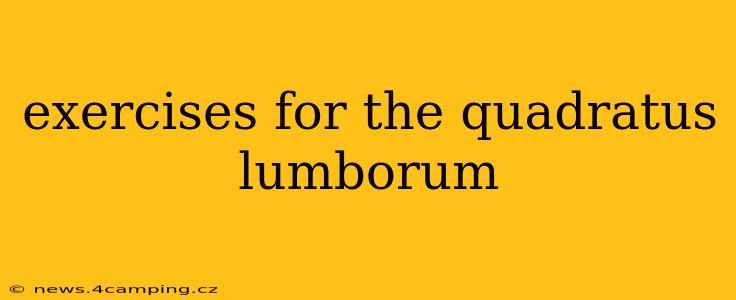The quadratus lumborum (QL) is a deep muscle in your lower back that plays a crucial role in stabilizing your spine and pelvis. Weak QL muscles can contribute to lower back pain, poor posture, and decreased athletic performance. Strengthening your QL is essential for overall core strength and injury prevention. This guide will provide you with several effective exercises to target this important muscle group, answering many common questions along the way.
What are the Best Exercises to Strengthen the Quadratus Lumborum?
There's no single "best" exercise, as the ideal approach depends on your fitness level and any pre-existing conditions. However, certain exercises are particularly effective at isolating and strengthening the QL. These include:
-
Side Plank: This is a fantastic bodyweight exercise that effectively targets the QL, along with your obliques and hip abductors. Start by lying on your side with your legs extended and elbow directly beneath your shoulder. Raise your hips off the ground, forming a straight line from head to heels. Hold this position for as long as you can maintain proper form, gradually increasing the duration as you get stronger.
-
Bird-Dog: This exercise improves core stability and coordination while engaging the QL. Start on your hands and knees, maintaining a neutral spine. Extend one arm forward and the opposite leg backward simultaneously, keeping your core engaged. Slowly return to the starting position and repeat on the other side. Focus on maintaining a straight line from hand to hip to heel.
-
Dead Bug: Lie on your back with your knees bent at 90 degrees and your arms extended toward the ceiling. Slowly lower one arm towards the floor while simultaneously extending the opposite leg. Keep your lower back pressed to the ground throughout the exercise. Return to the starting position and repeat on the other side. This exercise helps improve core stability and control.
-
Standing Side Bend: This exercise targets the QL directly. Stand with your feet shoulder-width apart and place your hands on your hips. Slowly bend to one side, keeping your spine straight as much as possible. Hold for a few seconds, then return to the starting position and repeat on the other side. Avoid twisting your torso.
-
QL Stretch: While not a strengthening exercise, stretching your QL is crucial for maintaining flexibility and preventing injury. Lie on your back with your knees bent and feet flat on the floor. Gently pull one knee towards your chest while keeping the other leg flat on the floor. Hold for 30 seconds, then repeat on the other side.
What are some common mistakes to avoid when doing QL exercises?
Several common mistakes can hinder the effectiveness of QL exercises and potentially lead to injury. These include:
- Arching the back: Maintaining a neutral spine is paramount. Avoid arching your lower back during any of the exercises, as this can strain your spine and reduce QL activation.
- Using momentum: Focus on slow, controlled movements. Avoid using momentum to complete the repetitions, as this reduces the effectiveness of the exercise.
- Ignoring proper form: Prioritize proper form over the number of repetitions. It’s better to do fewer repetitions with correct form than many repetitions with poor form.
- Overtraining: Allow adequate rest between workout sessions. Overtraining can lead to injury and hinder progress.
How often should I do QL exercises?
Ideally, you should incorporate QL exercises into your routine 2-3 times per week. Allow for adequate rest between workouts to prevent overtraining. Listen to your body and adjust the frequency and intensity of your workouts as needed.
Are there any QL exercises I should avoid if I have lower back pain?
If you have lower back pain, it's crucial to consult with a physical therapist or healthcare professional before starting any new exercise program. They can assess your specific condition and recommend appropriate exercises that won't aggravate your pain. Some exercises may need to be modified or avoided altogether depending on the cause and nature of your pain.
How can I tell if I'm engaging my QL properly during exercises?
You should feel a deep burn in your lower back, specifically on the side of your torso, when performing QL exercises correctly. If you're not feeling this, you might be relying on other muscles to compensate. Focus on maintaining proper form and slow, controlled movements. If you're unsure, seeking guidance from a qualified professional is advisable.
By consistently performing these exercises and paying close attention to proper form, you can effectively strengthen your quadratus lumborum, improve your core stability, and reduce your risk of lower back pain. Remember to always listen to your body and consult a healthcare professional if you experience any pain.
